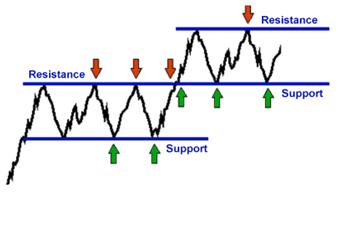Technical Analysis of Stocks – Support & Resistance
TechnicalAnalysisofStocksSupportResistance.aspx
How to find SUPPORT and RESISTANCE?
Introduction
Support and resistance identify areas of supply and demand. But what exactly is supply and demand? Supply is an area on a chart where sellers are likely going to overwhelm buyers causing the stock to go down. On a chart, we call this resistance. Demand is an area on a chart where buyers are likely going to overwhelm sellers causing the stock to go up. On a chart, we call this support.
Knowing this, it only makes sense to buy at support and sell at resistance! In the financial markets, prices are driven by excessive supply (down) and demand (up). Supply is synonymous with bearish, bears and selling. Demand is synonymous with bullish, bulls and buying. As demand increases, prices advance and as supply increases, prices decline. When supply and demand are equal, prices move sideways as bulls and bears slug it out for control. There are varying degrees of support and resistance.
- On the long side: When a stock falls down to a prior low it is more significant than when a stock falls down to a prior high.
- On the short side: When a stock rises up to a prior high it is more significant that when a stocks rises up to a prior low.
Support and resistance is one of the most widely used concepts in trading. Strangely enough, everyone seems to have their own idea on how you should measure support and resistance.
Let's take a look at the basics first.

What is SUPPORT?
Support is the price level at which demand is thought to be strong enough to prevent the price from declining further. The logic dictates that as the price declines towards support and gets cheaper, buyers become more inclined to buy and sellers become less inclined to sell. By the time the price reaches the support level, it is believed that demand will overcome supply and prevent the price from falling below support. After a support level is penetrated, it often becomes a resistance level; this is because investors want to limit their losses and will sell later, when prices approach the former level.

What is RESISTANCE?
Resistance is the price level at which selling is thought to be strong enough to prevent the price from rising further. The logic dictates that as the price advances towards resistance, sellers become more inclined to sell and buyers become less inclined to buy. By the time the price reaches the resistance level, it is believed that supply will overcome demand and prevent the price from rising above resistance. After a resistance level is penetrated, it often becomes a support level; this is because buyers who didn't buy at that price before it went up are now willing to buy at that price.
The concept of SUPPORT AND RESISTANCE is essential to understanding and interpreting the markets. Just as a ball bounces when it hits the floor or drops after being thrown to the ceiling, support and resistance define natural boundaries for rising and falling prices
Buyers and sellers are constantly in battle mode. Support defines that level where buyers are strong enough to keep price from falling further. Resistance defines that level where sellers are too strong to allow price to rise further. Support and resistance play different roles in up trends and downtrends. In an uptrend, support is where a pullback from a rally should end. In a downtrend, resistance is where a pullback from a decline should end.
Support and resistance are created because price has memory. Those prices where significant buyers or sellers entered the market in the past will tend to generate a similar mix of participants when price again returns to that level. When price pushes above resistance, it becomes a new support level. When price falls below support, that level becomes resistance. When a level of support or resistance is penetrated, price tends to thrust forward sharply as the crowd notices the BREAKOUT and jumps in to buy or sell. When a level is penetrated but does not attract a crowd of buyers or sellers, it often falls back below the old support or resistance. This failure is known as a FALSE BREAKOUT.
Support and resistance come in all varieties and strengths. They most often manifest as horizontal price levels. The length of time that a support or resistance level exists determines the strength or weakness of that level. The strength or weakness determines how much buying or selling interest will be required to break the level. Also, the greater volume traded at any level, the stronger that level will be.
Support and resistance exist in all time frames and all markets. Levels in longer time frames are stronger than those in shorter time frames.

How can Support & Resistant Levels help you make profitable trading decisions?
Identification of key support and resistance levels is an essential ingredient to successful and profitable trading. Being aware of the support and resistant levels of stocks and indices can greatly enhance analysis and forecasting abilities. If a security is approaching an important support level, it can serve as an alert to be extra vigilant in looking for signs of increased buying pressure and a potential reversal. If a security is approaching a resistance level, it can act as an alert to look for signs of increased selling pressure and potential reversal.
If a support or resistance level is broken, it signals that the relationship between supply and demand has changed. A resistance breakout signals that demand (bulls) has gained the upper hand and a support break signals that supply (bears) has won the battle.